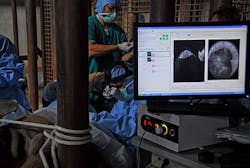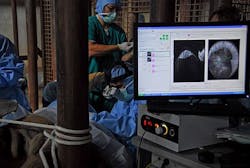Cataract surgery performed on elephant using SD-OCT
Marking the first time that a spectral-domain optical coherence tomography (SD-OCT) imaging system has ever been used on an elephant, veterinarians performed the surgical removal of a cataract from Câsar, a 38-year-old African elephant residing at the North Carolina Zoo, using such a system. The surgery, which took place in November 2011, also represents the fifth time that elephant cataract surgery has been performed anywhere in the world.
The SD-OCT system (Bioptigen's Envisu R2300) allowed the veterinarians to visualize the cornea, the cataract, and the capsular bag prior to surgery using low-power, near-infrared light. Then, they generated real-time, depth-resolved, high-resolution images of ocular microstructures from the cornea to the retina. Also, the system's handheld scanner allowed the surgeons to bring the system directly to the elephant, says Dr. Eric Buckland, Bioptigen president and CEO, as the four-hour surgery was performed in the zooâs elephant barn.
Dr. Richard J. McMullen Jr., assistant professor of ophthalmology at the College of Veterinary Medicine at N.C. State University, removed the cataract from Câsarâs eye. McMullen and his team had hoped to implant a specially created artificial lens in Câsarâs eye, but damaged tissue could not support it, he says. Had the lens been used, it would have been the first artificial lens implantation ever performed on an elephant.
The lack of a replacement lens means Câsar will see farsighted but should function just fine, says McMullen. He adds that artificial lens implantation following cataract removal only recently has been adapted in the horse.
North Carolina Zoo officials say that Câsarâs behavior has improved dramatically since surgery to the extent that they hope he can resume grazing in one of his three-and-a-half acre savannahs this spring. He has been sheltered within his barn and paddock since last March after cataracts in both eyes essentially blinded him, preventing him from safely and confidently roaming in larger spaces.
For more information, please visit http://bioptigen.com/news_Bioptigen_Zebrafish_Elephants.html.
-----
Follow us on Twitter, 'like' us on Facebook, and join our group on LinkedIn
Follow OptoIQ on your iPhone; download the free app here.
Subscribe now to BioOptics World magazine; it's free!

